MOMORDICA
Momordica
L., Sp. Pl. 2: 1009. 1753; Lu & Jeffrey, Fl. China 19: 28; Nazim. & Naqvi, Fl. Pak @ eFloras.org p. 4.
Annual or perennial herbs, scandent, creeping or climber. Tendrils unbranched or 2-fid. Petiole usually glandular; leaf blade orbicular or ovate-cordate, palmately 3-7-lobed, rarely undivided, entire or dentate. Plants dioecious or monoecious. MALE FLOWERS: Solitary or in a raceme; pedicel often with a large bract; bract orbicular-reniform. Calyx tube short, campanulate or cupulate; lobes ovate, lanceolate or oblong-lanceolate. Corolla yellow or white, rotate or broadly campanulate, 5-lobed; lobes obovate, oblong or ovate-oblong. Stamens (2 or) 3 (or 5); filaments short, free; anthers coherent at first, one 1-celled, others 2- celled; anther cells reflexed, straight or curved; connective not produced. Rudimentary ovary glandular or absent. FEMALE FLOWERS: Calyx and corolla as in male flowers. Tricarpellary, syncarpous; ovary oblong or fusiform, unilocular, ovules numerous, horizontal, placentation parietal; style elongate; stigmas 3, undivided or 2-lobed. Fruit ovoid, oblong, elliptic or fusiform, undivided or 3-valved, usually verrucose or spinescent. Seeds few or numerous, ovate or oblong, smooth or reticulate.
51 species
Momordica balsamina
Momordica balsamina
L., Sp. Pl. 1009. 1753; Clarke in Hook. f., Fl. Brit. Ind. 2: 617. 1879; Boiss., Fl. Or. 2: 757. 1872; Chakravarty, Monogr. Ind. Cucurbit. in Rec. Bot. Surv. India 17: 90. 1959; Cooke, Fl. Pres. Bomb. 1: 562. 1903; Jafri, Fl. Kar. 321. 1966; Stewart in Nasir & Ali, Ann. Cat. Vasc. Pl. W. Pak and Kashmir 705. 1972; Jaffery, Kew Bull. 34: 790. 1980; Chakravarty, Fasc. Fl. India 11: 88. 1982; Kaur & Sharma, Fl. Sirmaur 313. 2004; Nazim. & Naqvi, Fl. Pak. @ eFloras.org p. 5; Fl. North Amer. @ eFloras.org vol. 6.
Annual climber, monoecious. Tendrils simple, glabrous, up to 11 cm long. Stem pubescent to glabrescent. Leaves orbicular, ca. 3-4 cm long and 3.5-5 cm broad, cordate, glabrous or scantily hairy especially on veins, 3-5-lobed or -partite, middle lobe broadly ovate or rhombic-ovate, margin sinuate-dentate or acutely lobulate; leaf lobes and lobules apiculate. Petiole 1-3 cm long, pubescent. Flowers unisexual, actinomorphic or slightly zygomorphic, epigynous, yellow or creamish yellow, 2.5-3.0 cm across, pedicellate or pedunculate. MALE FLOWERS: Solitary axillary. Pedicel/peduncle ca. 3.5-5 cm long, puberulent; bracteate near the apex, bracts sessile, broadly ovate-cordate to reniform, subglabrous, dentate or denticulate. Calyx ca. 1 cm x 1 cm, reticulately veined, puberulent, apiculate; tube ca. 3 mm long, pubescent; lobes 5, ovate-lanceolate, acuminate, 6-7 mm x 3-3.5 mm, puberulent. Corolla slightly zygomorphic, rotate or campanulate, brown or orange at base; lobes 5, pale green or yellowish green, obovate or oblong, 10-15 mm x 8-10(-12) mm, apex obtuse, retuse, puberulent. Stamens 3, one 1-celled and two 2-celled, filaments ca. 3 mm long, free, broad at base, slightly puberulent. FEMALE FLOWERS: Solitary axillary, ca. 1.3 cm across; peduncle/pedicel short, ca. 1 cm long, bracteate, bract similar to as in male flowers, ca. 1 cm x 1 cm, puberulent, apiculate, attached nearly at base or halfway; calyx and corolla as in male flowers. Staminodes 3, glandular. Tricarpellary, syncarpous; ovary fusiform, puberulous, surface longitudinally minutely tuberculate, unilocular, ovules many, placentation parietal; style cylindrical, 1.5 mm long; stigma 3-lobed, each lobe bifid, stigma 2 mm long. Fruit broadly ovoid, narrowed at ends, 2-4(-7) cm x 1-2.5 cm, orange red, tuberculate. Seeds elliptic- ovate, 1-1.2 cm x 6-7 mm.
Common Names: Balsam Apple, Balsam Pear, Southern Balsam Pear, African Cucumber; Baad (Hedge) Karela, Jangli Karela, Jhaar Karela (Hindi)
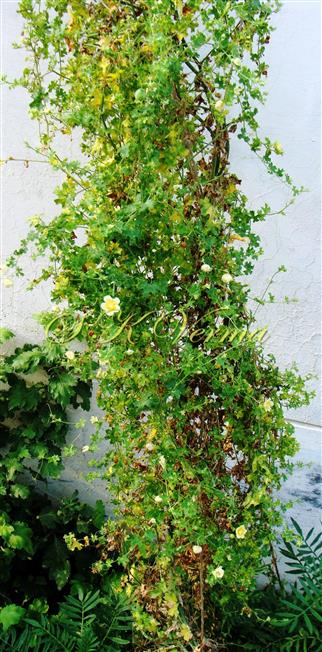
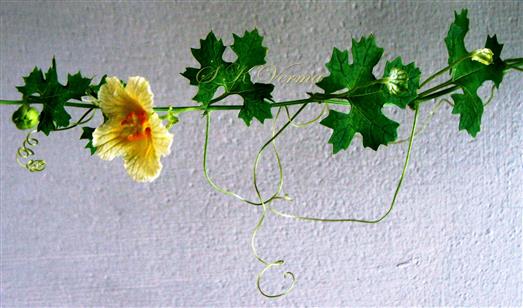
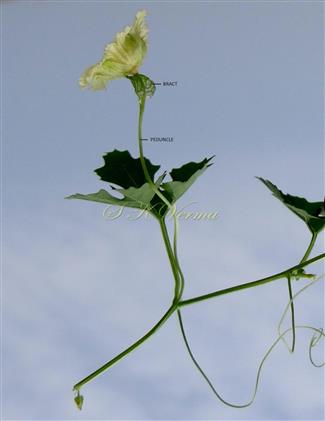
-5913.jpg)
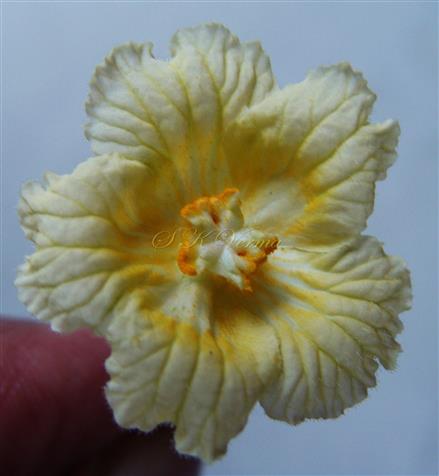
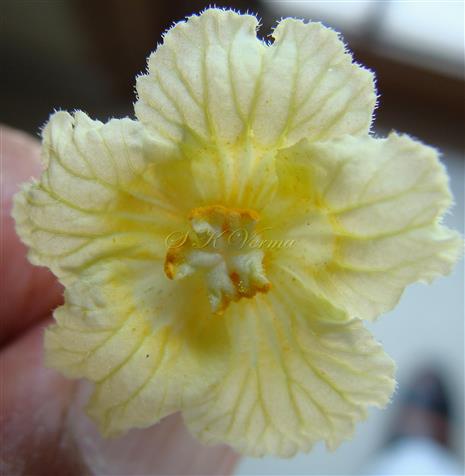
-0320.jpg)
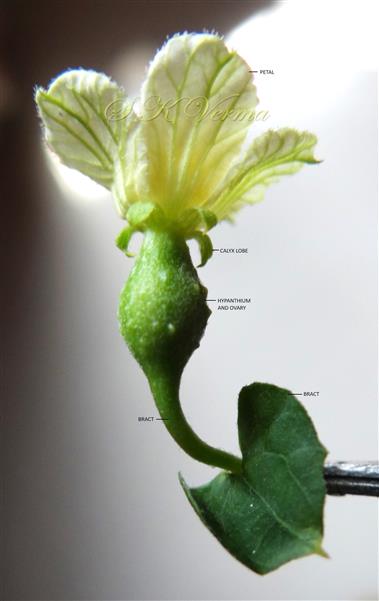
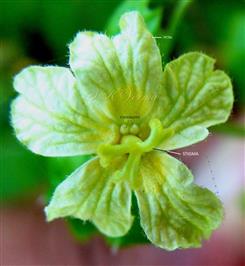
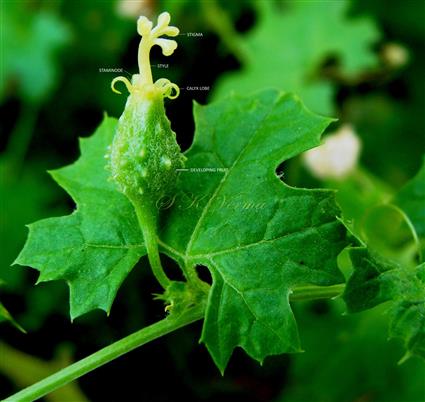
-DSC00654.jpg)
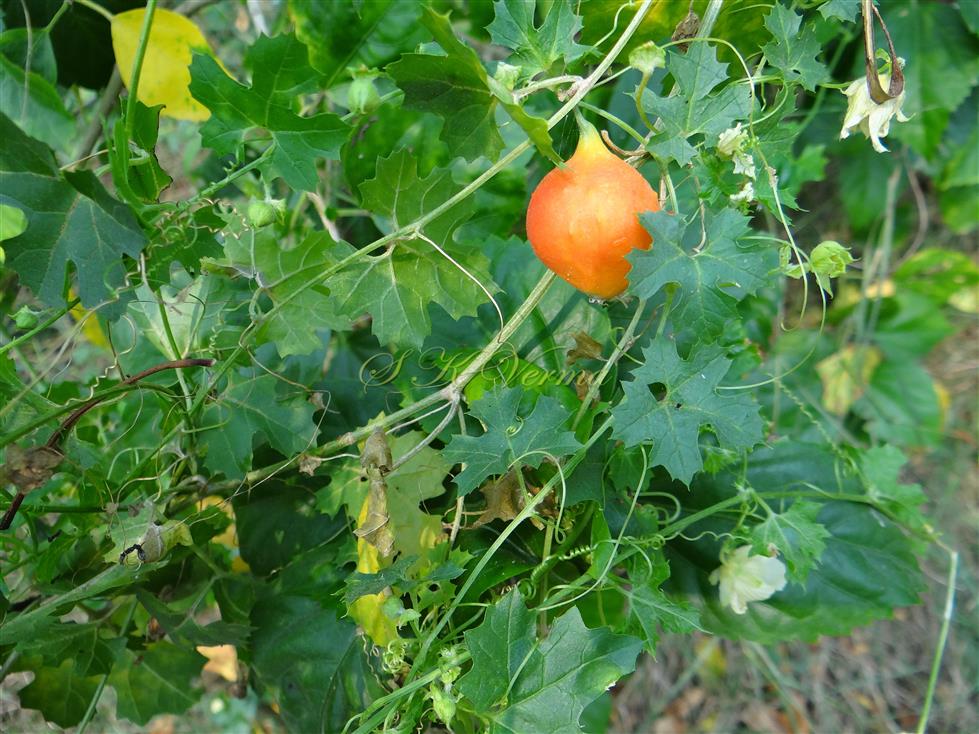




-5913.jpg)


-0320.jpg)



-DSC00654.jpg)
